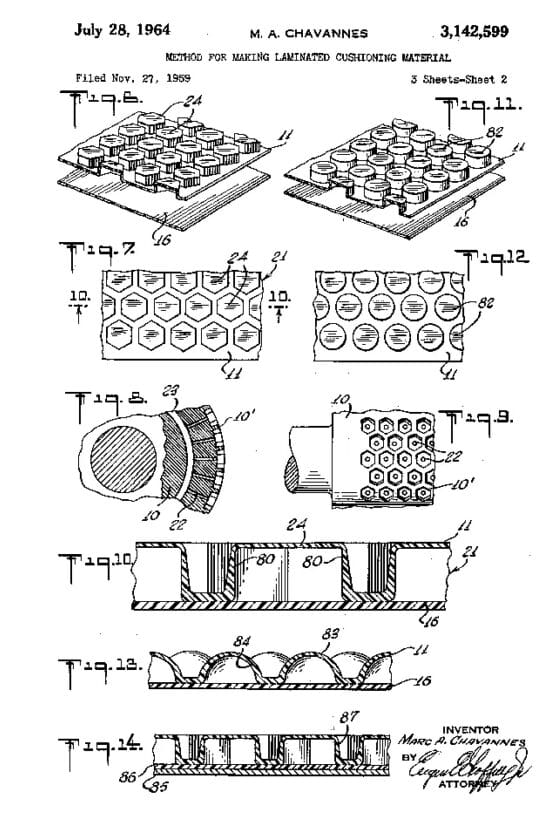Many people like to pop packaging film with air bubbles because this activity supposedly reduces stress. We decided to check whether this belief is supported by scientific evidence.
This method of stress relief is written about not only sites film manufacturers, but also federal And regional media, business publications and even portals about music. Article under name “Punk-punk: that’s why popping bubbles in packaging film is the best anti-stress” can be found on the health and healthy lifestyle website “Doctor Peter.”
With the invention of bubble wrap, humanity obliged engineer Alfred Fielding and chemist Mark Chavan. In 1957, they were working on creating unusual wallpaper and decided to connect plastic sheets so that small air bubbles formed between them. The idea was to launch a textured, “bubble” wallpaper that could be an interesting design solution. When buyers showed no interest in this idea, the inventors, paying attention to the thermal insulation properties of the film, tried to use the technology in insulating greenhouses. However, this development did not become commercially successful.
Then Fielding and Shawan came up with a new idea: to use the resulting material as packaging. In 1960, they founded the Sealed Air company and started production. Sales remained fairly modest until IBM became interested in the development, looking for packaging material to transport its new computers. Tests in independent laboratories, simulating drops on concrete, transportation in highly vibrating trucks and wagons, as well as airplanes, have shown the high reliability of such packaging. In 1971, sales were already $5 million, and by the beginning of the 21st century they reached $3 billion.

Presumably, the first person who came up with the idea of popping bubbles on such a film was was Alfred Fielding's five-year-old son Howard. He recalls that he was once watching an action-packed film, and his father’s invention lay next to him on the sofa. To reduce the tension from what was happening on the screen, the boy began to click bubbles on the film with his fingers, and this fascinated him. Fielding Jr. said: “I remember looking at things packaged in such film and having an intuitive desire to snap it. It’s unlikely that I’m the first person who started popping bubbles on this film; probably the employees at my father’s company also popped it, but only to check the quality. Instead, I'm most likely the first to do it for my own pleasure. It was a lot of fun to pop these bubbles, they used to be much bigger and therefore burst with a loud sound.”
Stress is a fairly broad concept. Canadian endocrinologist Hans Selye, who introduced this term into scientific use, determined it as a nonspecific reaction of the body to any demand presented to it. Now WHO describes stress as a natural human reaction that helps to focus on problems or threats that arise in everyday life. By opinion According to Harvard Medical School, stress negatively affects brain function, causing memory loss, problems with concentration, and decreased efficiency in performing daily tasks. British non-profit organization "Mental Health Foundation" notesthat the emotional manifestations of stress can be very different - from anxiety and fear to anger, sadness, irritation and depression. In addition, severe stress, manifested in the form of irritability, withdrawal and aggressiveness, Maybe worsen relationships with others.
Although scientists are actively looking for effective ways to combat stress, they are not so interested in non-drug therapies - there is very little research on how bubble wrap can help in this matter. In 1992, one of them spent American psychologist Caitlin Dillon. She divided 30 students into two groups and asked them to fill out a questionnaire about their psychological state. The experimenter was interested in whether the students felt energetic, tense, tired, and calm. The first group was asked to sit in silence for five minutes and then fill out the questionnaire again. The second group spent this break popping bubble wrap. After completing the questionnaire for the second time, the groups switched roles and then re-rated their psychological state. Immediately after bursting the film, all students noted that they felt more energetic and calm, as well as less tired. The level of tension did not change. Dillon notes that bubble wrap has a number of advantages over other relaxation methods - for example, it does not require prior preparation to burst, and the likelihood of a paradoxical increase in anxiety is unlikely, unlike, for example, meditation.
In 2011, the Sealed Air company itself became interested in the anti-stress properties of its product, and at its request Kelton Research spent corresponding survey. 1,191 US residents aged 18 years and older took part in it. Having studied the respondents' answers, sociologists reportedthat a minute of popping bubble wrap helps relieve stress better than a half-hour session of a relaxing massage. Those surveyed who popped bubble wrap in the week before participating in the study were less likely to say they were worried about their health than those who had not done so in the past seven days (34% vs. 40%). Although the findings are interesting, they have two significant drawbacks: firstly, the survey was conducted with the money of a company interested in promoting its product, and secondly, a detailed description of the study and its methodology is not publicly available.
Researcher Katherine Isbister from the University of California is studying the effects of different toys on stress. The focus of her attention included pop-its that simulate the bursting of bubble wrap. Research results not published, however, the interim results for Isbister in 2021 shared with The Conversation. Such toys, her respondents reported, help them stay focused during a long task and attentive during a long meeting. Adults resort to pop-its to achieve a relaxed and meditative state, and children - to distract themselves and thereby cope with negative emotions.
However, data on the effectiveness of popping bubble wrap as a stress reliever is limited and scientists have not compared it to other relaxing activities. It is completely impossible to conduct the most reliable blind study in which some participants will burst bubble wrap, and some will not, while remaining unaware of what process they were engaged in. However, science does not know any negative consequences of bursting bubble wrap, so if this stress-relieving practice is suitable for someone, then there is no reason not to use it.
Cover image: GPT 4o
If you find a spelling or grammatical error, please let us know by highlighting the error text and clicking Ctrl+Enter.






